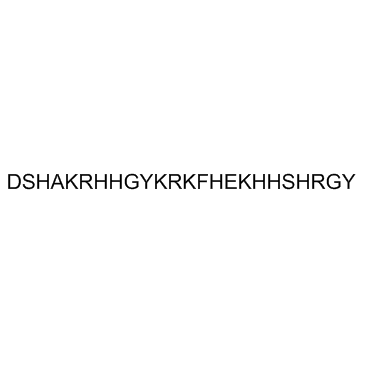| Description |
Histatin 5 inhibits the activity of the host matrix metalloproteinases MMP-2 and MMP-9 with IC50s of 0.57 and 0.25 μM, respectively.
|
| Related Catalog |
|
| Target |
IC50: 0.57 μM (MMP-2), 0.25 μM (MMP-9)[1]
|
| In Vitro |
Histatin 5 is a member of a family of low-molecular-weight salivary proteins secreted by parotid, submandibular, and sublingual glands. Using biotinylated gelatin as a substrate, Histatin 5 is found to inhibit the activity of the host matrix metalloproteinases MMP-2 and MMP-9 with IC50s of 0.57 and 0.25 μM, respectively. To localize the domain responsible for this inhibition, three peptides containing different regions of Histatin 5 are synthesized and tested as inhibitors of MMP-9. Peptides comprising residues 1 to 14 and residues 4 to 15 of Histatin 5 show much lower inhibitory activities (IC50, 21.4 and 20.5 μM, respectively), while a peptide comprising residues 9 to 22 showed identical activity to Histatin 5 against MMP-9. Kinetic analysis of the inhibition of the Arg-gingipain reveals that Histatin 5 is a competitive inhibitor, affecting only the Km with a Ki of 15 μM[1]. Histatin 5 is an inhibitor of mitochondrial respiration.The human salivary antifungal peptide Histatin 5 is taken up by Candida albicans cells and associates intracellularly with mitochondria. Histatin 5 inhibits respiration of isolated C. albicans mitochondria as well as the respiration of intact blastoconidia in a dose and time-dependent manner. Histatin 5 at a concentration of 33 uM inhibits state 2 respiration[2].
|
| Kinase Assay |
MMP-2 and MMP-9 are tested using biotinylated gelatin-coated microtiter plates as a substrate. In this assay, estimation of enzyme activity is based on the loss of bound biotin resulting from proteolytic activity against the gelatin-biotin complex adsorbed to the wells of microtiter plates. A stock solution of 5.4 μM MMP-9 is diluted to 10.8 nM in enzyme buffer consisting of 50 mM Tris-HCl (pH 7.5) containing 0.5 M NaCl and 5 mM CaCl2. The diluted enzyme is activated by adding 1 mM 4-aminophenylmercuric acetate and is further incubated at room temperature for 30 min. Histatin 5 at concentrations ranging from 0.005 to 100 μM is incubated with activated enzyme for 10 min before being added to the microtiter plates. The same procedure is carried out with peptide 1, peptide 2, and peptide 3. As a positive control, EDTA is used at 25 mM. After incubation of the appropriate inhibitor with the enzyme, the wells of a microtiter plate are filled with 50 μL of this mixture and the plate is incubated at 37°C for 2 h. Wells containing enzyme without inhibitor are used to determine maximal activity (100%). Wells containing substrate and buffer alone are used as controls, representing no activity (0%). To stop the reactions, the plate is washed three times with 200 μL of PBS containing 1% Tween 20. Subsequently, 50 μL of streptavidin-alkaline phosphatase (1:2, 500 dilution in water) is added to each well, and the plate is incubated for 15 min at 37°C. The plate is then washed four times with 200 μL of PBS-Tween, and 200 μL of pNPP dissolved in diethanolamine buffer (1 mg of pNPP per mL of buffer) is added for 20 min at 37°C. The absorbance is recorded at 405 nm using a microtiter plate reader[1].
|
| References |
[1]. Gusman H, et al. Salivary histatin 5 is an inhibitor of both host and bacterial enzymes implicated in periodontaldisease. Infect Immun. 2001 Mar;69(3):1402-8. [2]. Helmerhorst EJ, et al. The human salivary peptide histatin 5 exerts its antifungal activity through the formation ofreactive oxygen species. Proc Natl Acad Sci U S A. 2001 Dec 4;98(25):14637-42.
|


